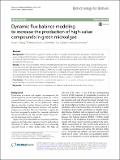Dynamic flux balance modeling to increase the production of high-value compounds in green microalgae
Author(s)
Fachet, Melanie; Höffner, Kai; Sundmacher, Kai; Flassig, Robert J.; Barton, Paul I
Download13068_2016_Article_556.pdf (2.040Mb)
PUBLISHER_CC
Publisher with Creative Commons License
Creative Commons Attribution
Terms of use
Metadata
Show full item recordAbstract
Background
Photosynthetic organisms can be used for renewable and sustainable production of fuels and high-value compounds from natural resources. Costs for design and operation of large-scale algae cultivation systems can be reduced if data from laboratory scale cultivations are combined with detailed mathematical models to evaluate and optimize the process.
Results
In this work we present a flexible modeling formulation for accumulation of high-value storage molecules in microalgae that provides quantitative predictions under various light and nutrient conditions. The modeling approach is based on dynamic flux balance analysis (DFBA) and includes regulatory models to predict the accumulation of pigment molecules. The accuracy of the model predictions is validated through independent experimental data followed by a subsequent model-based fed-batch optimization. In our experimentally validated fed-batch optimization study we increase biomass and β-carotene density by factors of about 2.5 and 2.1, respectively.
Conclusions
The analysis shows that a model-based approach can be used to develop and significantly improve biotechnological processes for biofuels and pigments.
Date issued
2016-08Department
Massachusetts Institute of Technology. Department of Chemical Engineering; Massachusetts Institute of Technology. Process Systems Engineering LaboratoryJournal
Biotechnology for Biofuels
Publisher
BioMed Central
Citation
Flassig, Robert J. et al. “Dynamic Flux Balance Modeling to Increase the Production of High-Value Compounds in Green Microalgae.” Biotechnology for Biofuels 9.1 (2016): n. pag.
Version: Final published version
ISSN
1754-6834